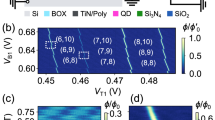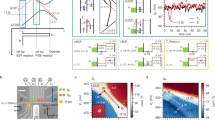Abstract
Spin qubits based on interacting spins in double quantum dots have been demonstrated successfully1,2. Readout of the qubit state involves a conversion of spin to charge information, which is universally achieved by taking advantage of a spin blockade phenomenon resulting from Pauli's exclusion principle. The archetypal spin blockade transport signature in double quantum dots takes the form of a rectified current3. At present, more complex spin qubit circuits including triple quantum dots are being developed4. Here we show, both experimentally and theoretically, that in a linear triple quantum dot circuit the spin blockade becomes bipolar5 with current strongly suppressed in both bias directions and also that a new quantum coherent mechanism becomes relevant. In this mechanism, charge is transferred non-intuitively via coherent states from one end of the linear triple dot circuit to the other, without involving the centre site. Our results have implications for future complex nanospintronic circuits.
This is a preview of subscription content, access via your institution
Access options
Subscribe to this journal
Receive 12 print issues and online access
$259.00 per year
only $21.58 per issue
Buy this article
- Purchase on Springer Link
- Instant access to full article PDF
Prices may be subject to local taxes which are calculated during checkout




Similar content being viewed by others
References
Petta, J. R. et al. Coherent manipulation of coupled electron spins in semiconductor quantum dots. Science 309, 2180–2184 (2005).
Hanson, R. & Burkard, G. Universal set of quantum gates for double-dot spin qubits with fixed interdot coupling. Phys. Rev. Lett. 98, 050502 (2007).
Ono, K., Austing, D. G., Tokura, Y. & Tarucha, S. Current rectification by Pauli exclusion in a weakly coupled double quantum dot system. Science 297, 1313–1317 (2002).
Gaudreau, L. et al. Coherent control of three-spin states in a triple quantum dot. Nature Phys. 8, 54–58 (2012).
Hsieh, C-Y., Shim, Y-P. & Hawrylak, P. Theory of electronic properties and quantum spin blockade in a gated linear triple quantum dot with one electron spin each. Phys. Rev. B 85, 085309 (2012).
Arimondo, E. in Progress in Optics XXXV (ed. Wolf, E.) Ch. 5, 257–354 (Elsevier, 1996).
Brandes, T. & Renzoni, F. Current switch by coherent trapping of electrons in quantum dots. Phys. Rev. Lett. 85, 4148–4151 (2000).
Michaelis, B., Emary, C. & Beenakker, C. W. J. All-electronic coherent population trapping in quantum dots. Europhys. Lett. 73, 677–683 (2006).
Ratner, M. A. Bridge-assisted electron transfer: effective electronic coupling. J. Phys. Chem. 94, 4877–4883 (1990).
Greentree, A. D., Cole, J. H., Hamilton, A. R. & Hollenberg, L. C. L. Coherent electronic transfer in quantum dot systems using adiabatic passage. Phys. Rev. B 70, 235317 (2004).
Johnson, A. C., Petta, J. R., Marcus, C. M., Hanson, M. P. & Gossard, A. C. Single–triplet spin blockade and charge sensing in a few-electron double quantum dot. Phys. Rev. B 72, 165308 (2005).
Koppens, F. H. L. et al. Control and detection of singlet–triplet mixing in a random nuclear field. Science 309, 1346–1350 (2005).
Granger, G. et al. Three-dimensional transport diagram of a triple quantum dot. Phys. Rev. B 82, 075304 (2010).
Busl, M., Sánchez, R. & Platero, G. Control of spin blockade by ac magnetic fields in triple quantum dots. Phys. Rev. B 81, 121306(R) (2010).
Amaha, S. et al. Resonance-hybrid states in a triple quantum dot. Phys. Rev. B 85, 081301(R) (2012).
Blum, K. Density Matrix, Theory and Applications 2nd edn, Ch. 8 (Plenum, 1996).
Acknowledgements
The authors thank P. Hawrylak and C.Y. Hsieh for discussions. M.B., R.S. and G.P. acknowledge financial support from the Spanish Ministry of Education (grant no. MAT2011-24331, MEC) and from the Marie Curie Initial Training Network (grant no. 234970, EU). M.B. and R.S. were supported by the Consejo Superior de Investigaciones Científicas through the JAE and JAE-Doc programmes, co-financed by the Fondo Social Europeo. G.G. acknowledges funding from the National Research Council Canada – Centre national de la recherche scientifique collaboration and Canadian Institute for Advanced Research. A.S.S. acknowledges funding from the Natural Sciences and Engineering Research Council of Canada and the Canadian Institute for Advanced Research.
Author information
Authors and Affiliations
Contributions
M.B. and R.S. performed the theoretical calculations. A.K. fabricated the TQD device on a 2DEG heterostructure. Z.R.W. optimized and grew the 2DEG heterostructure. G.G., L.G. and S.A.S. performed the experiments and analysis. M.P.L. assisted with these measurements and analysis. P.Z. assisted with the experiments. M.B., G.G., R.S., A.S.S. and G.P. wrote the paper. A.S.S. and G.P. supervised the experimental and theoretical components of the collaboration.
Corresponding author
Ethics declarations
Competing interests
The authors declare no competing financial interests.
Supplementary information
Supplementary information
Supplementary information (PDF 774 kb)
Rights and permissions
About this article
Cite this article
Busl, M., Granger, G., Gaudreau, L. et al. Bipolar spin blockade and coherent state superpositions in a triple quantum dot. Nature Nanotech 8, 261–265 (2013). https://doi.org/10.1038/nnano.2013.7
Received:
Accepted:
Published:
Issue Date:
DOI: https://doi.org/10.1038/nnano.2013.7
This article is cited by
-
Review of performance metrics of spin qubits in gated semiconducting nanostructures
Nature Reviews Physics (2022)
-
Single hole spin relaxation probed by fast single-shot latched charge sensing
Communications Physics (2019)
-
Coherent spin-exchange via a quantum mediator
Nature Nanotechnology (2017)
-
Coherent long-distance displacement of individual electron spins
Nature Communications (2017)
-
Ferromagnetic Phase in Nonequilibrium Quantum Dots
Scientific Reports (2017)



